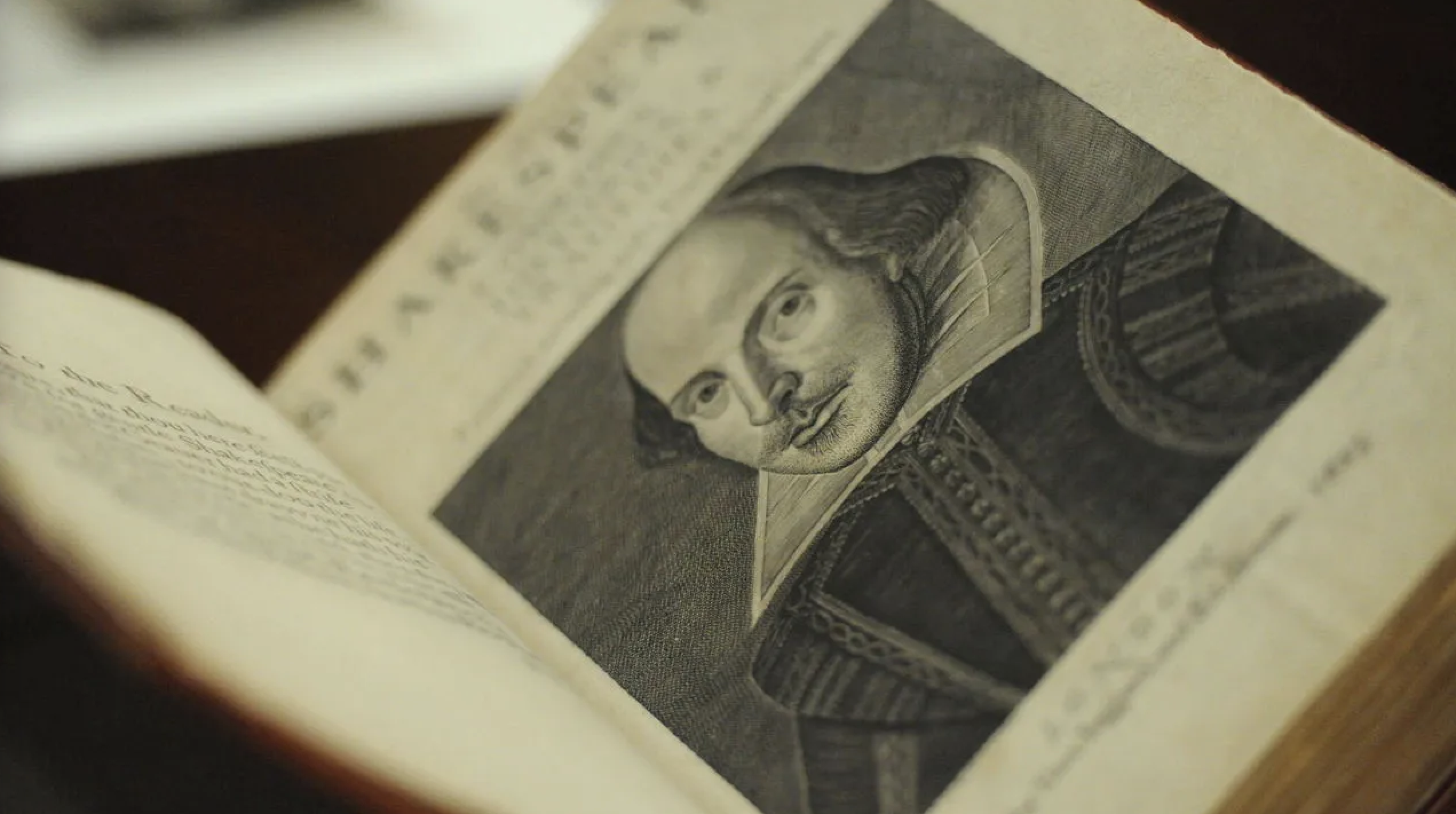

Compilation of images EL&L instructors have chosen to represent their 2023/2024 courses. See article for in-depth explanations and image credits.
The study of English language and literatures is both about the beauty of the written word and the expansive impact it has on every aspect of our existence. Taught with imagination, flexibility, and critical thinking, English Language & Literatures courses at UBC equip students with novel approaches to navigating an increasingly complex world while teaching them to advocate for themselves clearly and creatively within it.
Whether you’re looking to challenge yourself with new perspectives on already familiar texts, or want to centre queer, Black scholarship on the cutting edge of experimental form, the UBC Department of English Language & Literatures offers many courses that will keep the pages turning.
Check out a selection of the inspiring courses offered by UBC EL&L below, and be sure to browse our full 2023/2024 course catalogue.
ENGL 491E: Black Miscellanea: Black Experiments in Form
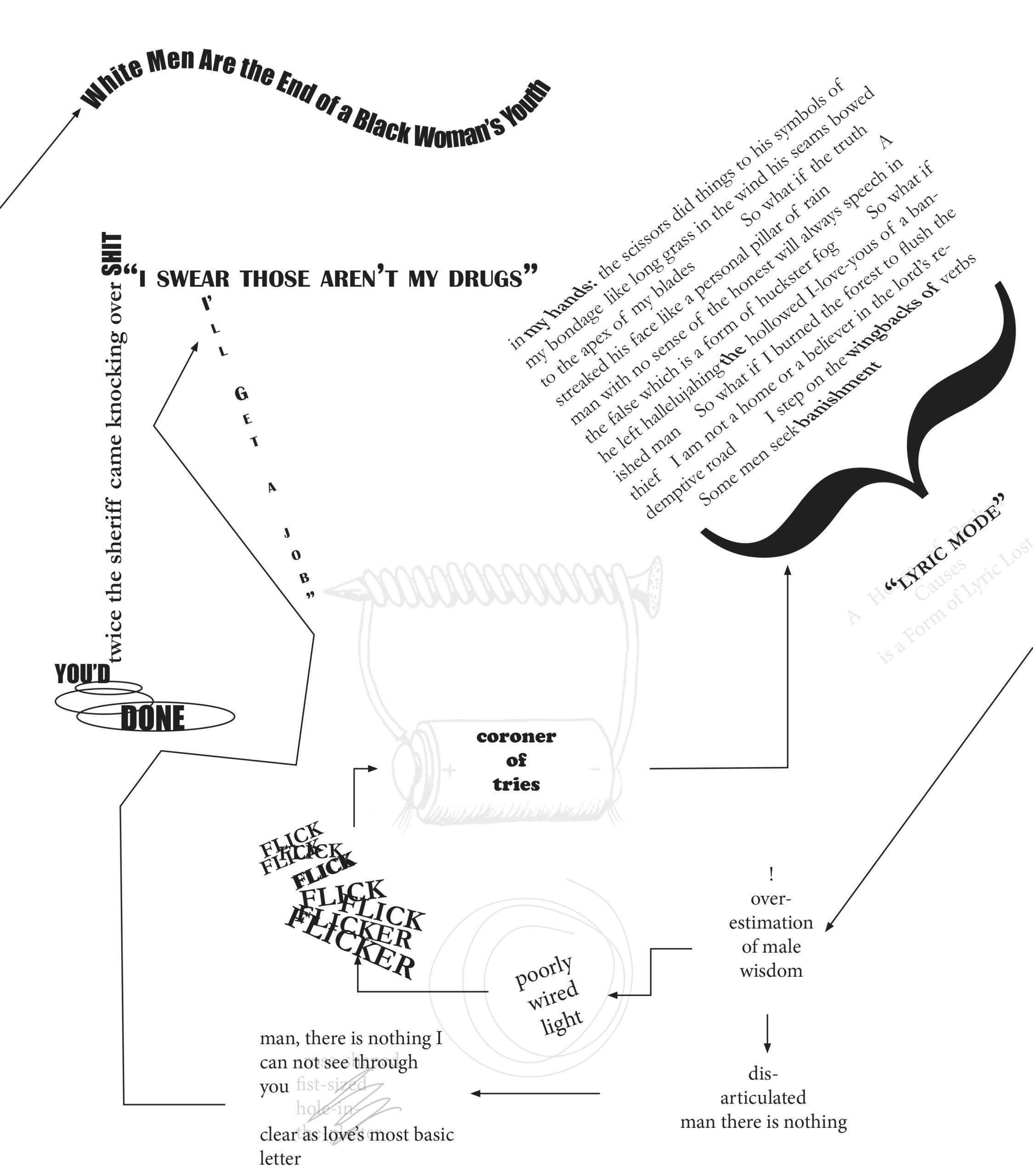

White Men Are the End of a Black Woman’s Youth by Lillian-Yvonne Bertram.
Instructor: Dr. Kimberly Bain (she/her/hers)
Why did you choose this image to represent ENGL 491E: Black Miscellanea: Black Experiments in Form?
This course takes up considerations of Black experimental thought, methods, and forms to consider the question of Black life in the contemporary moment. The Bertram poem—at once a visual, lexical, and schematic experience and experiment—captures some of the ways Black folk reimagine “a way of thinking the space/time of politics for those deemed disposable or socially dead within the contexts of heteropatriarchy and white supremacy” (Audre Lorde), and attends to questions of the disjunctive, the genre flail, the palimpsestic, the miscellaneous, and so forth.
What can students expect from this innovative Honours seminar?
Students should expect a blend of theory, artistic productions, and artistic practice. Most of the texts we’ll be exploring will be by Black scholars, activists, and artists who are trying their hands at forms and practices that haven’t been defined, and as such are building a grammar. Readings will be difficult and sometimes lengthy, without a doubt; but it will also be rewarding.
I’m excited for all the novel forms we’ll be exploring in this course. It will be my first time offering this course and I want to bring into it an ethos of expansive thought and curiosity. I hope the students will as well, especially as we’ll be trying our hand at some of these forms ourselves. Is it possible for a literature course to also be an art course? I don’t know—but together we’ll find out.
ENGL 375: Global South Connections: South Asian Speculative Futures
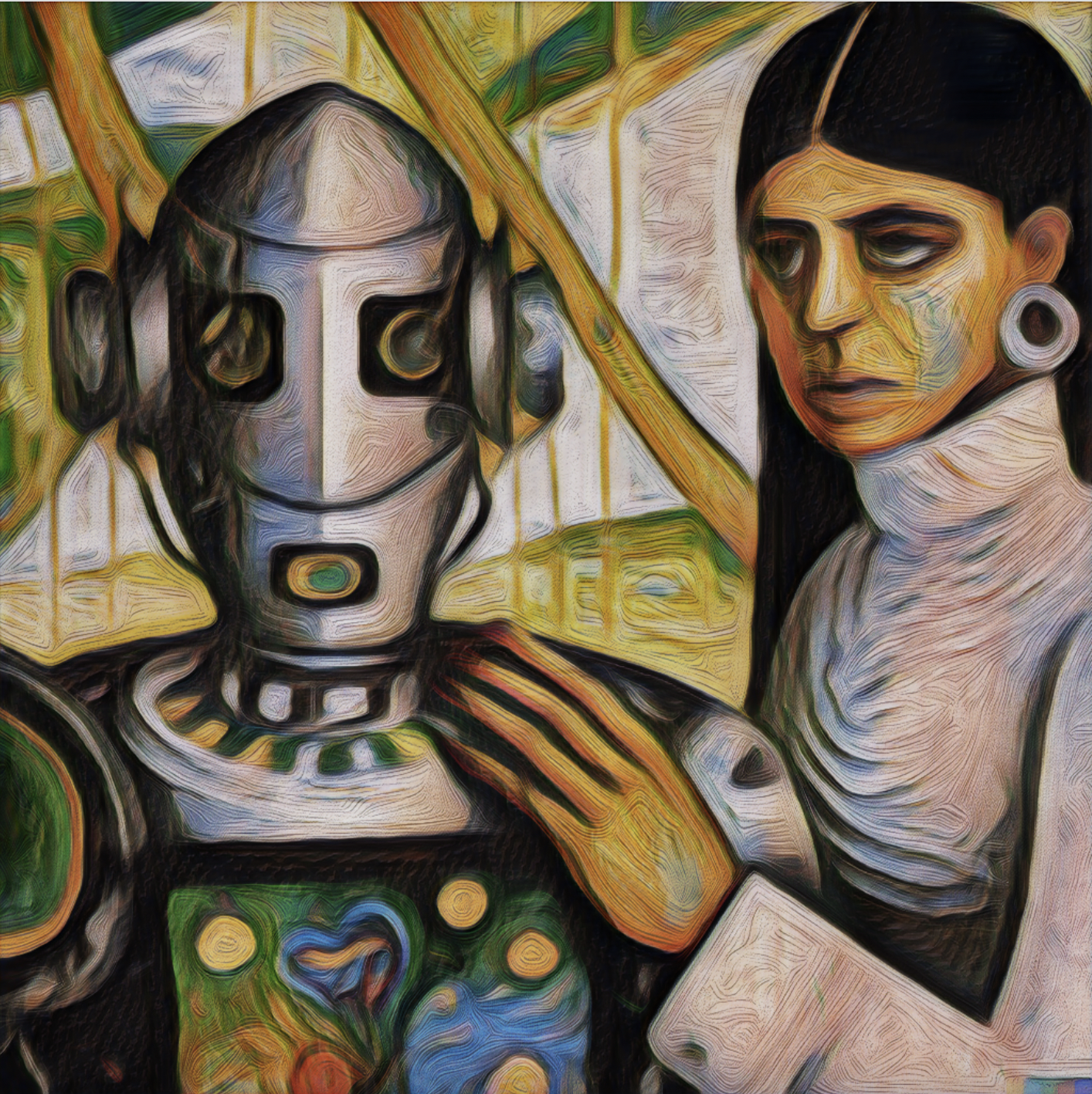

Science-fiction art genre with robot and scientist as an illustration. Science fiction art, Science is Evil by David S. Soriano. Image via Wikipedia.
Instructor: Dr. Kavita Philip
Why did you choose this image to represent ENGL 375: Global South Connections: South Asian Speculative Futures?
Science fiction, speculation, future anxiety, race, gender, and technology, visually represented in this painting by David S. Soriano, are all topics that are critical to the course.
What can students expect from this course?
This course investigates the global connections between politics, development and literature sparked by the wave of decolonization that occurred in the middle of the twentieth century. Taking up South Asian decolonization as an exemplary case study, we will read speculative fiction from the region, paired with essays on Global South histories of decolonization, development, and political radicalism. What did decolonization mean, politically and culturally? What kinds of literary and cultural movements did it inspire? How did dreams of political freedom influence theories of utopia and experiments in fiction? These will all be questions we take up in this course.
Readings from this course will focus on speculative futurism from the South Asian subcontinent, as well as primary texts from the historical moment of decolonization (mid 20th century). We will read texts by Nalo Hopkinson, Uppinder Mehan, Amitav Ghosh, Mimi Mondal, Vandana Singh, Sami Shah, Yudhanjaya Wijeratne, Rokeya Sakhawat Hossain, Robin D. G. Kelley, and others.
ENGL 318: History of the English language: Early History
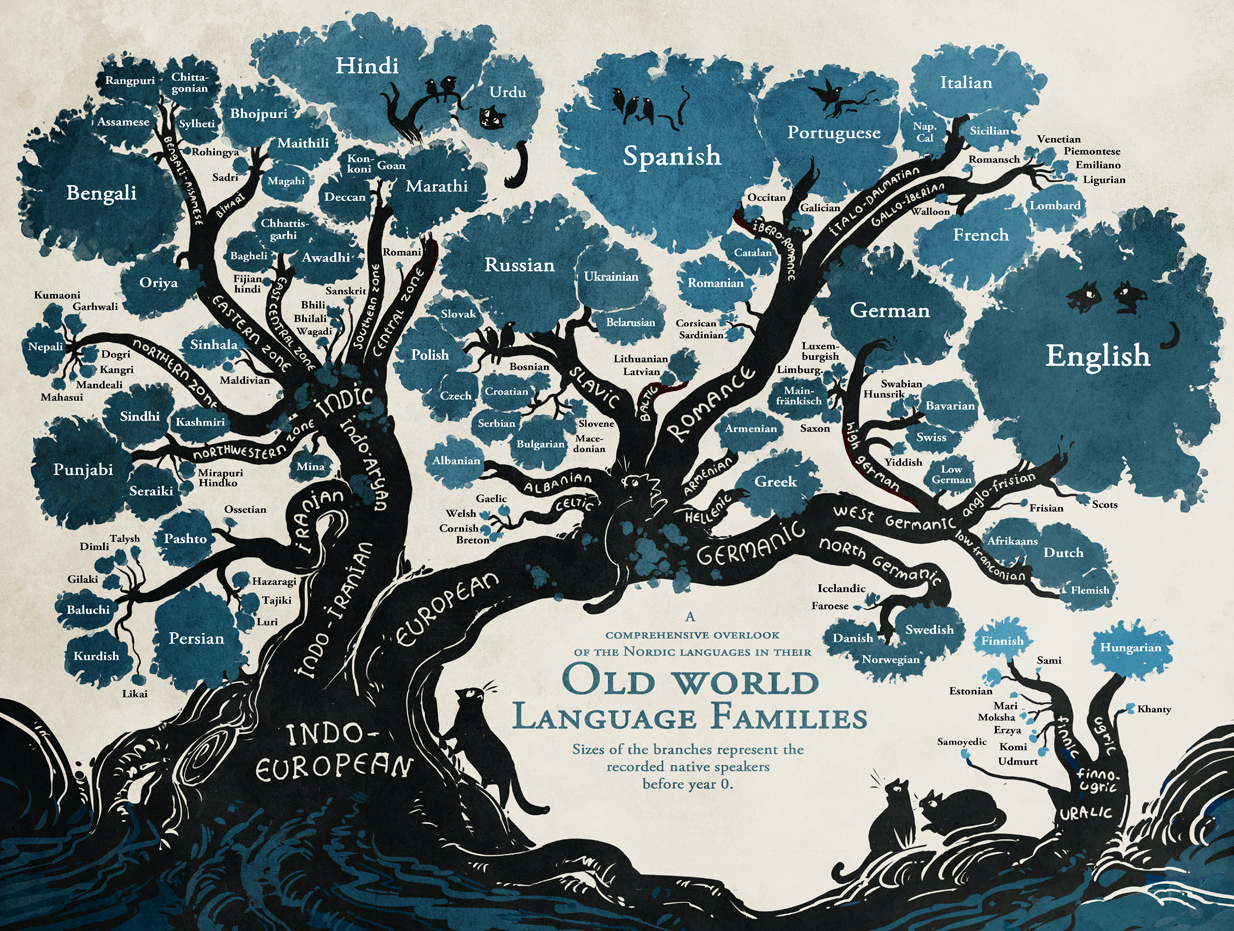

An artistic depiction of the Indo-European family tree. Image by Minna Sundberg, via Stand Still, Stay Silent.
Instructor: Dr. James Stratton (he/him/his)
Why did you choose this image to represent ENGL 318: History of the English language: Early History?
This is a graphic depiction of the family tree for Indo-European languages by comic artist Minna Sundberg, which appears as a part of her webcomic Stand Still, Stay Silent. English is related to over 400 languages spoken today. Some are more closely related to English, like German, others are more distantly related, like Hindi and Greek. This course discusses how these languages started out as the same, but diverged over time, with English taking its own unique path.
What can students expect from this course?
There is something in this course for everyone. We will learn about theory through Scrabble and Chutes and Ladders. We will learn about important historical events that shaped the history of English through hilarious memes and videos. Prepare to be shocked to learn what the best and worst Early Medieval kings did in their time.
Students will leave the course with the ability to explain many of the “irregularities” of Present Day English through knowledge of language history. Our approach will be an interdisciplinary one, drawing on evidence from linguistics, literature, history, historiography, and archeology.
ENGL 392 99A: “Down the Rabbit Hole”: Child, Nation and British Fantasy Literature
Online Asynchronous
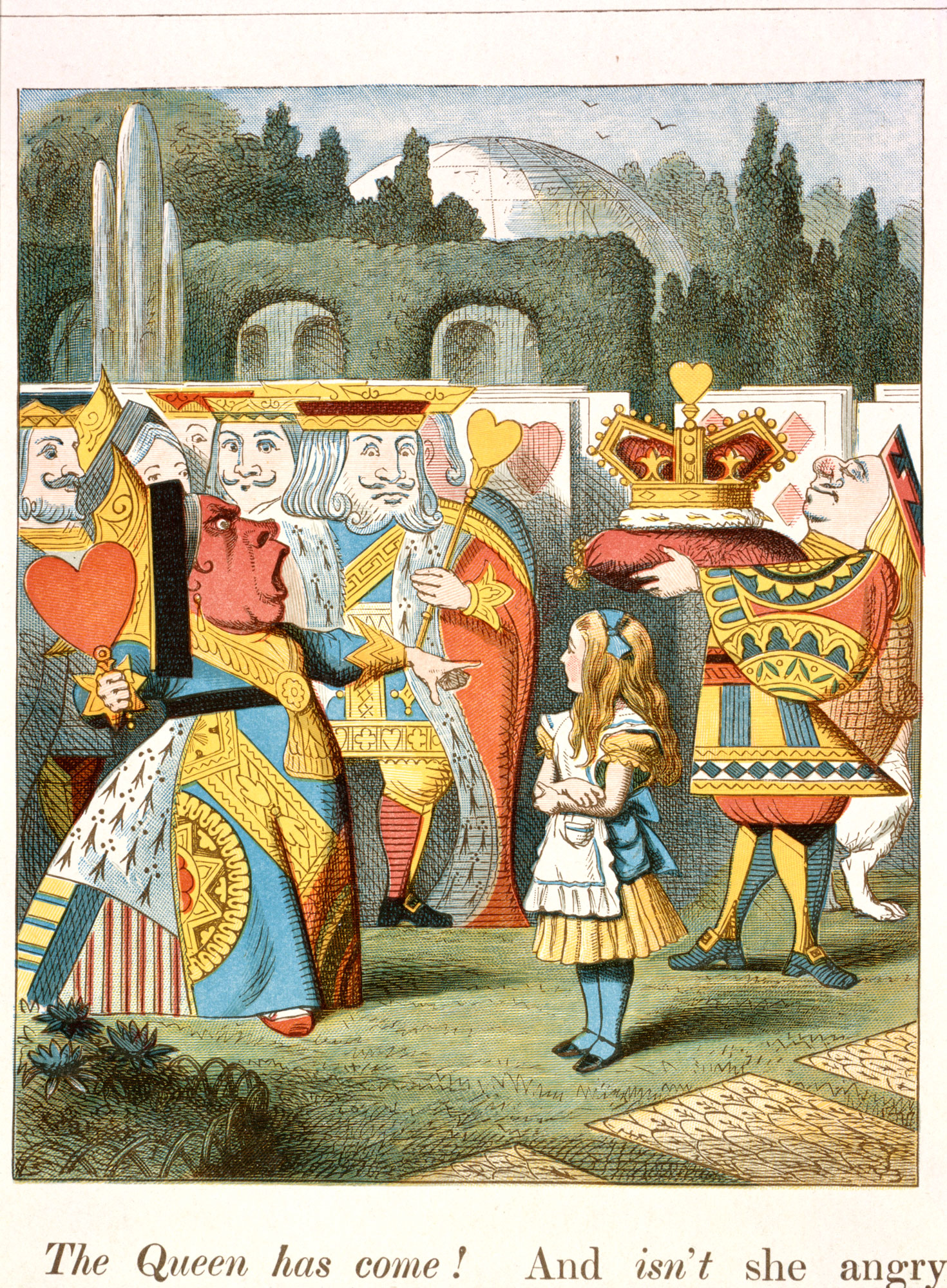

Illustration from The Nursery Alice, containing twenty coloured enlargements from Tenniel's illustrations to Alice's Adventures in Wonderland, with text adapted to nursery readers by Lewis Carroll. London: Macmillan and Co. 1890. Taken from British Library item Cup.410.g.74. Image via Wikipedia.
Instructor: Dr. Sarika Bose (she/her/hers)
Why did you choose this image to represent ENGL 392 99A: “Down the Rabbit Hole”: Child, Nation and British Fantasy Literature?
Alice’s Adventures in Wonderland represents and anticipates all the thrills of adventure and exploration at the heart of the British fantasy and quest books we will be reading in this course. Alice and the Wonderland inhabitants’ mutual questioning and discomfort with what is “normal” or “logical” sparks our own self-reflections.
What can students expect from this fully online asynchronous course?
In this fully asynchronous course, students can expect to take charge of their own learning, while guided by lecture materials, notes and scholarly readings, and to share their ideas formally, through essays, and informally, through discussion posts, peer reviews and games. Background in theories of children’s literature is not needed, but you should have experience in writing literary analysis and in reading and applying scholarly criticism to your essays.
Much of classic British children’s literature provides a starting point for understanding Western cultural commonplaces, and the excitement and wonder child characters feel at encountering the world anew continues to be replicated in our reading experiences as adults today. This course’s texts will be conduits to a critical exploration of culture and identity.
ENGL 346 Chaucer’s Canterbury Tales: A World of Words and a Sea of Stories
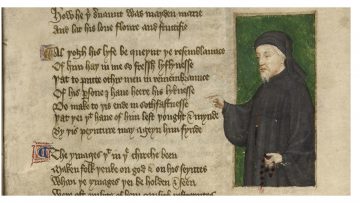

Portrait of Chaucer by Thomas Hoccleve in the Regiment of Princes, 1412.
Instructor: Dr. Stephen Partridge
Why did you choose this image to represent ENGL 346 Chaucer’s Canterbury Tales: A World of Words and a Sea of Stories?
The Canterbury Tales operates on at least two levels. The more obvious level is that of the pilgrims’ competition to tell the best tale, but behind them all, of course, is Chaucer the author, who occasionally reminds us of his presence in a rather postmodern way.
What can students expect from this course on one of the most well-known texts in English literature?
I enjoy teaching how to read aloud and understand Chaucer’s language, and seeing students perceive their progress with these skills. I also like to teach through open discussion that reflects the format of the Canterbury Tales, in which pilgrims take turns offering sharply different perspectives on many shared themes.
There will be two translation quizzes, and students will prepare two passages for reading aloud in class. Students have the choice of writing three short papers on set topics throughout the term, or writing a term paper on a topic they choose. There will be a final exam.
ENGL 378: U.S. Fiction of the 1970s
Octavia Butler's note to herself in her commonplace notebook, 1988, from her archive at the Huntington Library. Image via the Huntington Library.

Instructor: Dr. Jeff Severs (he/him/his)
Why did you choose this image to represent ENGL 378: U.S. Fiction of the 1970s?
In this course we will read Octavia Butler’s 1979 novel Kindred, which is about slavery and time travel. This note she wrote to herself captures her ambitions for her work. I love how it not only takes us inside the writer’s mind but makes us want to read and interpret her work with a matching passion.
What can students expect from your class?
This is a course for students who want to read U.S. greats in depth. In addition to Butler, we’ll read Don DeLillo’s End Zone, Toni Morrison’s Song of Solomon, Tim O’Brien’s Going After Cacciato, and Joan Didion’s Democracy. We’ll also read some remarkable essays in the vein of New Journalism that define this era. For course work, students can expect two close-reading-driven essays and a final exam.
I’m excited to help students understand the novel’s ability to speak back to its cultural moment and to U.S. history.
ENGL 350: Milton Between Men


''Richard Humphries, the Boxer'' by John Hoppner.
Instructor: Dr. Elizabeth Hodgson (she/her/hers)
Why did you choose this image to represent ENGL 350: Milton Between Men?
John Milton, the celebrity writer of the English Revolution, strove for and assumed a type of masculinity depicted in this painting: aggressive, performative, clever, independent, and confrontational. That model of manhood in his famous works will be our focus in this course.
What can students expect from this course, which interrogates masculinity in Milton’s most famous work?
In our current moment when Ted Lasso’s stories about manhood meet Andrew Tate’s, I’m really looking forward to seeing how students respond to the kinds of men and types of masculinity that they find in John Milton’s epic works. We’ll concentrate on Milton’s Paradise Lost for our readings. It’s not a long read, but a rich one. Participation, presentations, group work and research writing will all be collaborative ways we learn together.
ENGL 322 99C: Stylistics
Online Asynchronous
Ted Hughes’s poem, 'To Paint a Water Lily', makes a key appearance in ENGL 322.

Instructor: Dr. Ina Biermann
Why did you choose this image to represent the course?
The image shows something of the beautiful shimmering of a dragonfly that we see above the water, but there is much hidden below the surface that we cannot know about unless we know about the life cycle of this insect. Similarly, stylistic analysis reveals how crucial it is to grasp what is communicated by the language details of a work of literature. We realize this when carefully observing the language of “To Paint a Water Lily” by Ted Hughes and all the other texts we will be reading in the course.
What can students expect from this online asynchronous course?
The course will have a steadily paced workload guiding students through the course lessons. We will have graded and self-testing exercises, graded discussions, two collaborative workshops, an individual term paper, reading a short story using specific techniques employed in it that have been identified by recent work in corpus stylistics on the author’s style, and a final exam.
I am looking forward to students’ responses when matching their own small-scale study of a single short story to published large-scale corpus stylistics findings about the style of the same author. I’m also excited to know how students’ initial interpretation compares to the way they interpret the story after doing this work.
ENGL 347: Madness and Folly in the Renaissance


Three Marginal Drawings in a copy of _The Praise of Folly_ by Erasmus of Rotterdam: Folly in the Pulpit (no. 1); A Scholar Treads on a Market Woman's Basket of Eggs (no. 3); and Sertorius and the Example of the Horses (no. 15). Image via Wikipedia Commons.
Instructor: Dr. Nancy Frelick
Why did you choose this image to represent the course?
This image presents a detail from Hans Holbein’s marginal drawings for a copy of The Praise of Folly by Erasmus. This is one of the texts we’ll be studying.
What can students expect from ENGL 347: Madness and Folly in the Renaissance?
We will focus on close readings of texts, using a comparative perspective. Assignments will be based on our readings. It will be fun to explore the fascinating material on madness and folly in the Renaissance with participants, especially during in-class discussions.
English 348 99C: “Author’s Pen” and “Actor’s Voice”: Shakespeare in Text and Performance
Onnline Asynchronous
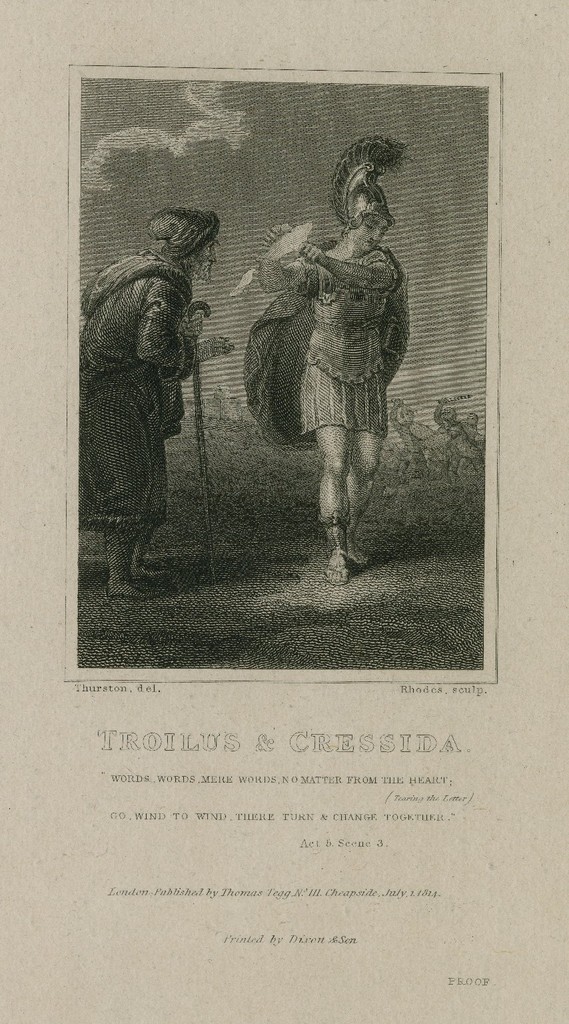

Troilus tearing up a letter from Cressida from an illustrated edition of Shakespeare (~1814).
Instructor: Dr. Gavin Paul (he/him/his)
Why did you choose this image to represent English 348 99C: “Author’s Pen” and “Actor’s Voice”: Shakespeare in Text and Performance?
A character destroying a text nicely captures the complicated and wonderful relationship between page and stage, which is the overarching focus of the course.
What can students expect from this asynchronous course?
We will be watching selections from contemporary performances of the plays on our reading list, and I am always excited to hear reactions to these performances. Students always notice things that I haven’t, and I look forward to them seeing things from perspectives I hadn’t considered.
In terms of course content, students can look forward to reading five very different plays and discussing them with their classmates. There are two essays to write that provide students with the opportunity to pursue their particular interests in more detail.
ENGL 110: Fictions of the Queer Past


Two people at a nightclub wearing wigs and make-up, posing for the camera. Reynaldo Rivera, ''Reynaldo Rivera: Provisional Notes for a Disappeared City'' (Semiotexte).
Instructor: Dr. Mo Pareles (they/them/theirs)
Why did you choose this image to represent the course?
This is the cover of Reynaldo Rivera’s book, Reynaldo Rivera: Provisional Notes for a Disappeared City, which documents the queer and trans Latine nightlife scene of late 20th-century LA. In our course, we will read a novel set in this period and look at some images from the past.
What can students expect from this section of ENGL 110?
We’ll read two intense novels and a few shorter readings; you will have a short paper and a couple of flash (really short papers). You will learn a lot and get to speak your mind in class discussion. I can’t wait to teach two of my favourite novels – Carolina de Robertis’s Cantoras and Michael Nava’s Carved in Bone.
ENGL 351: Restoration and Eighteenth-century Literature (A.K.A.: So much DRAMA! Eighteenth-century Theatre)
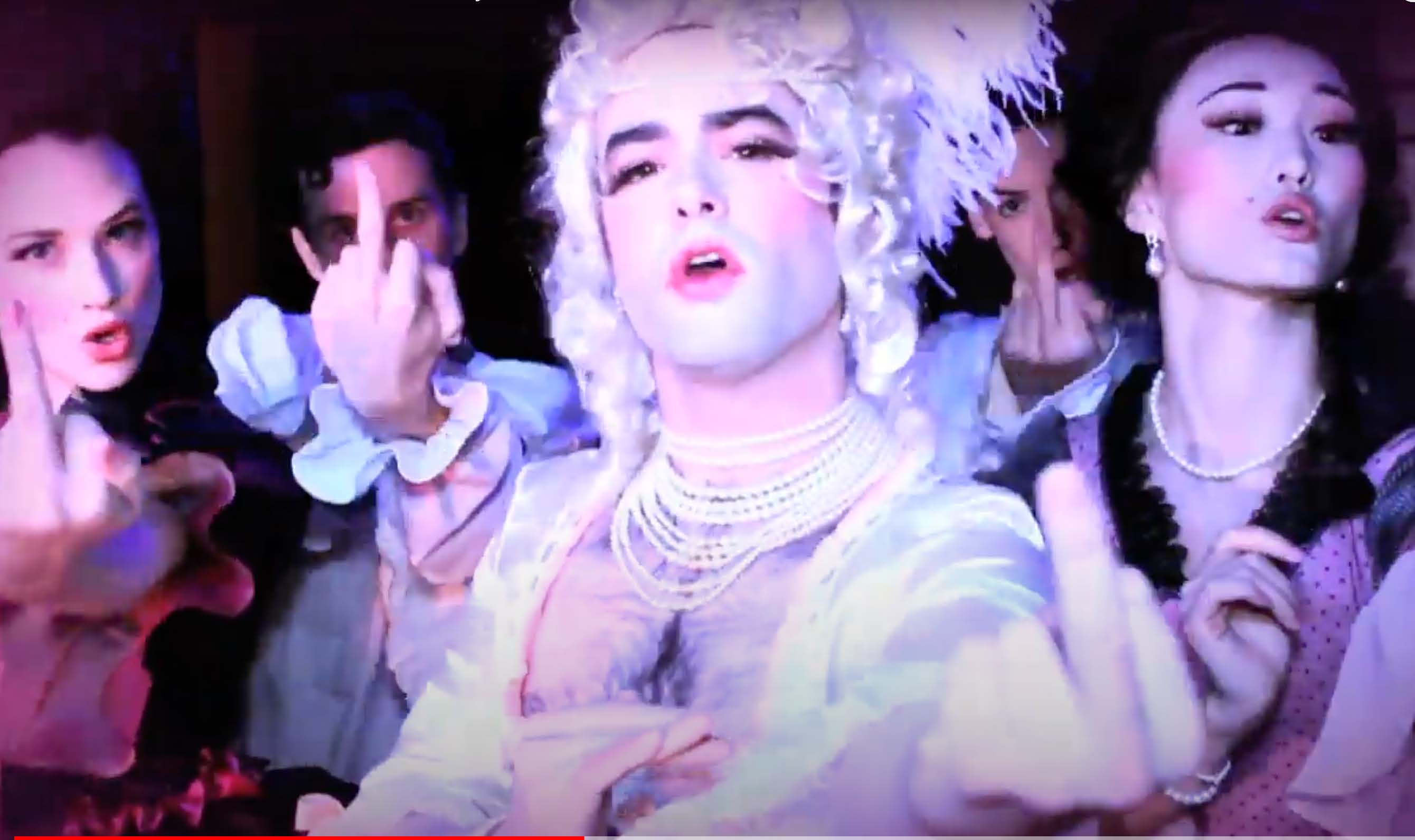

A screenshot from the ''Let's Have A Kiki: Restoration Comedy'' promo video for Amy Freed's 2012 adaptation at The Flea theatre.
Instructor: Dr. Tiffany Potter (she/her/hers)
Why did you choose this image to represent ENGL 351: Restoration and Eighteenth-century Literature?
Restoration comedy was disruptive and sometimes shocking in its own day, and this image from a modern adaptation (at New York’s alternative Flea Theatre) conveys that brilliantly. The Restoration was a cultural moment of drama, where the stage refracted some serious culture wars, especially around gender, sexuality and power.
What can students expect from ENGL 351, besides the drama?
We will study six plays, with a flexible assignment structure, including a final exam. You will get to read a play called The Convent of Pleasure and also find out why Henry Fielding might be the first post-modern dramatist.
I’m very excited for students to meet these plays! I’m also excited about teaching restoration drama in general. The Guardian sells it well: “London is greedily expanding; marriage is misery but strangers are dangers. Ever worry about getting paid, getting laid or finding love? Does social anxiety prickle your palms? Do you despair of a world slipping its moorings? Restoration drama may speak to you.” (“Sex, Money and Idiots in Power: Restoration Comedy’s Endless Appeal”, 2019).

